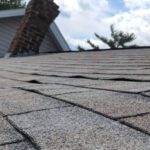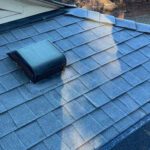What Temperature is Too Cold for Roofing in Minnesota?
Roofing in Minnesota is a task that requires careful planning and consideration due to the state’s notorious winters and temperature extremes. As a trusted Minnesota roofing company, we understand the importance of knowing when it’s safe and efficient to undertake roofing projects. We dive deeper into the issues that arise when temperatures drop below freezing and explore how they can impact Minnesota roofing projects.
Sealant Bonding Issues
 One of the primary concerns when roofing in cold temperatures is the bonding of adhesive seals on roofing materials. Sealants play a crucial role in preventing water infiltration and ensuring the longevity of the roof. However, when the temperature drops too low, these sealants may not bond correctly, leading to potential leaks and reduced wind resistance.
One of the primary concerns when roofing in cold temperatures is the bonding of adhesive seals on roofing materials. Sealants play a crucial role in preventing water infiltration and ensuring the longevity of the roof. However, when the temperature drops too low, these sealants may not bond correctly, leading to potential leaks and reduced wind resistance.
Inadequate bonding can result in water seeping into the roof structure, causing damage to the underlying materials and promoting the growth of mold and mildew. Additionally, if the seals on shingles do not adhere properly, the roof’s ability to withstand strong winds can be compromised, increasing the risk of shingle uplift and damage during storms.
Shingle Flexibility and Durability
 Another significant issue when roofing in cold weather, especially below 40°F, is the flexibility and durability of roofing materials. Asphalt shingles, the most commonly used roofing material in Minnesota, can become brittle and lose their flexibility in cold weather conditions. This loss of flexibility makes them highly susceptible to cracking and breaking during installation or repairs.
Another significant issue when roofing in cold weather, especially below 40°F, is the flexibility and durability of roofing materials. Asphalt shingles, the most commonly used roofing material in Minnesota, can become brittle and lose their flexibility in cold weather conditions. This loss of flexibility makes them highly susceptible to cracking and breaking during installation or repairs.
When asphalt shingles are not flexible, it’s challenging to lay them flat and ensure a secure fit. This can lead to gaps or uneven surfaces on the roof, which can compromise the integrity of the roofing system. Moreover, brittle shingles are more likely to crack when exposed to stress, such as the weight of snow and ice during winter storms.
In extreme cases, shingle damage can be so severe that it necessitates the replacement of the entire roof. This can be a costly and time-consuming process for homeowners, making it crucial to avoid roofing in excessively cold temperatures.
Safety Concerns for Roofing Crews
 Roofing in freezing temperatures also poses significant safety concerns for roofing crews. The icy and slippery conditions on the roof increase the risk of accidents and injuries. Crew members may slip and fall, leading to injuries that can range from minor bruises to more severe issues like broken bones or concussions.
Roofing in freezing temperatures also poses significant safety concerns for roofing crews. The icy and slippery conditions on the roof increase the risk of accidents and injuries. Crew members may slip and fall, leading to injuries that can range from minor bruises to more severe issues like broken bones or concussions.
Safety is a top priority for any Minnesota roofing company, and roofing in excessively cold conditions can compromise the well-being of the crew. Project delays may occur due to weather-related accidents or injuries, which can result in additional costs and inconvenience for homeowners.
The Optimal Minnesota Roofing Temperature and Manufacturers Recommendations
Given the challenges posed by extremely cold temperatures, it’s essential for homeowners and roofing contractors to choose the right time for roofing projects in Minnesota. The optimal temperature range for roofing generally falls between 40°F and 85°F.
Within this temperature range, asphalt shingles maintain their flexibility and durability, making them easier to handle and install. The adhesive seals on roofing materials bond correctly, ensuring the roof’s integrity and weather resistance. Additionally, working in milder temperatures minimizes safety risks for roofing crews.
While most shingle manufacturers offer guidelines for optimal installation temperatures, they also specify that it is possible to install their products in lower or higher temperatures, provided that proper precautions and procedures are followed. Owens Corning and GAF suggests installing their shingles in temperatures above 40°F.
Navigating Minnesota’s Roofing Challenges
Roofing in Minnesota’s cold winters requires careful planning and consideration. Understanding the challenges posed by extremely cold temperatures, such as shingle flexibility, sealant bonding, and safety concerns, is crucial for the success of roofing projects.
As a trusted Minnesota roofing company, we emphasize the importance of choosing the right temperature for roofing work. The optimal temperature range, generally between 40°F and 85°F, ensures that roofing materials perform at their best and minimizes safety risks for roofing crews.
By planning ahead, monitoring weather forecasts, and selecting experienced contractors, homeowners can ensure that their roofing projects in Minnesota are completed efficiently and effectively. Choosing the right time and temperature for roofing work ultimately contributes to the longevity and durability of the roof, protecting the home from the challenges of the state’s notorious winters.

0 Comments